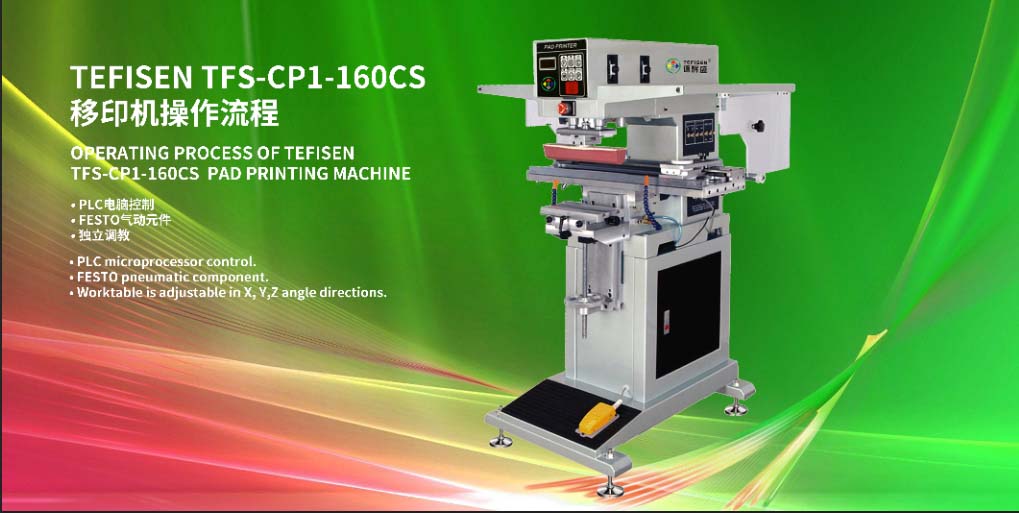Comprehensive Guide to Operating the High-speed Pad Printing Machine
The TFS-CP1-160CS high-speed pad printing machine from TEFISEN is renowned for its exceptional performance and versatility, making it a crucial asset in modern industrial printing. With a print area of 50 x 280mm and a standard steel plate size of 75 x 500mm, coupled with a φ60mm ink cup, this machine ensures stability and precision throughout the printing process. Its printing speed of up to 600 PCS/Hr significantly boosts production efficiency, making it suitable for various industries such as electronics, toys, and hardware, especially where high-precision printing is required. This article outlines the detailed operational process of the TFS-CP1-160CS high-speed pad printing machine, emphasizing safety, efficiency, and quality control.

Objectives of Standardizing the Operation Process
Ensuring Operational Safety
The primary objective of standardizing the operation process is to ensure the safety of the operator. Clear steps and precautions help prevent potential hazards and accidents, safeguarding the operator's well-being.
Enhancing Production Efficiency
Effective operational processes optimize workflow by eliminating unnecessary steps, thereby increasing the production efficiency of the pad printing machine. This is crucial for meeting production demands and shortening delivery times.
1. Guaranteeing Print Quality
Clear operational guidelines assist operators in adhering to standard procedures, ensuring consistent and stable print quality. This is vital for improving product quality and satisfying 2. customer requirements.
2. Reducing Equipment Failure Rates
Following correct operational procedures minimizes improper use of the equipment, reducing failure rates and extending the lifespan of the pad printing machine. This helps lower maintenance costs and improves overall equipment efficiency.
3. Improving Operator Skills
By learning and following operational procedures, operators can continually enhance their skills and knowledge. This not only increases their work efficiency but also equips them to quickly resolve issues when they arise.
Pre-Operational Preparations for the TFS-CP1-160CS High-speed Pad Printing Machine
Pre-operational preparations are crucial for the smooth operation of the pad printing machine. These include:
1. Equipment Inspection
Before operation, carefully inspect the TFS-CP1-160CS high-speed pad printing machine's exterior and components for any signs of damage, looseness, or electrical connection issues. This ensures normal startup and operation.
2. Environmental Cleanliness
Clean the machine's surface and the printing plate using specialized cleaning agents and soft cloths. Avoid using cleaners containing acids or bases to prevent damage to the machine's surface.
3. Environmental Conditions
The pad printing machine requires specific environmental conditions:
Temperature: Operate the machine within a temperature range of 18–25°C to prevent high or low temperatures from affecting print quality.
Humidity: Maintain an environmental humidity of 50%–70%. Excessive or insufficient humidity can cause printing materials to lose moisture or dry out, impacting print quality.
Operational Process of the TFS-CP1-160CS high-speed Pad Printing Machine
Once preparations are complete, the following steps outline the formal operation of the TFS-CP1-160CS high-speed pad printing machine:
Step 1: Ink Preparation
1.Select ink suitable for the material and color requirements of the printed product and ensure the ink quality is good.
2.Adjust the ink's viscosity and color according to printing requirements.
3.Pour the ink into the machine's ink tray and stir it evenly using a mixer.
Step 2: Steel Plate and Silicone Pad Preparation
1.Clean the steel plate to ensure no oil or dust on its surface.
2.Install the steel plate with the required pattern into the machine's plate holder, adjusting its position and pressure as necessary.
3.Choose a silicone pad of suitable size and hardness, and install it onto the machine's pad holder.
Step 3: Test Printing Adjustments
1.Place the workpiece to be printed on the machine's worktable and secure it.
2.Start the machine for a test print, observing the print quality, including the clarity and color saturation of the pattern.
3.Adjust the pad's pressure, speed, and stroke, as well as the ink's viscosity and color, based on the test print results until the desired print quality is achieved.
Step 4: Formal Printing
1.Set the machine to automatic operation mode after completing test print adjustments.
2.Sequentially place the workpieces on the worktable, allowing the machine to complete the printing process automatically.
3.Periodically check print quality and make timely adjustments to address any issues.
Considerations During Printing
1.Monitor the machine's operational status closely. If any abnormal sounds, vibrations, or fault indicator lights are observed, stop the machine immediately for inspection.
2.Regularly check the ink levels and add ink as needed to prevent print quality degradation due to insufficient ink.
3.Maintain a clean work environment to prevent contaminants such as dust and oil from entering the machine.
4.Follow operational guidelines strictly to avoid safety incidents and equipment damage due to improper operation.
Shutdown and Maintenance
1.Turn off the machine's power after completing the printing work.
2.Clean the machine's surface and interior of any ink and dust.
3.Conduct a thorough inspection and maintenance of the machine, including cleaning the silicone pad and steel plate and checking the tightness of all components.
4.Organize and store the machine's tools and accessories properly for future use.
In conclusion, the TEFISEN TFS-CP1-160CS high-speed pad printing machine is an advanced printing device with a seemingly complex operational process. However, with the right knowledge and techniques, it can be operated efficiently and effectively. By following the outlined steps and considerations, operators can ensure the machine's optimal performance and print quality, contributing significantly to production efficiency and product quality.
Understanding and mastering the operational procedures of the TFS-CP1-160CS high-speed pad printing machine is essential for any operator aiming to enhance their skills and contribute to their company's success. This guide provides a comprehensive framework for achieving consistent, high-quality results, making it an invaluable resource for both novice and experienced operators in the industrial printing sector.

